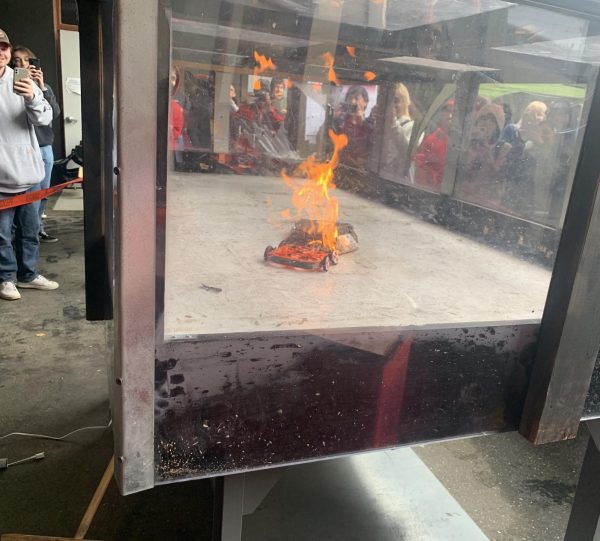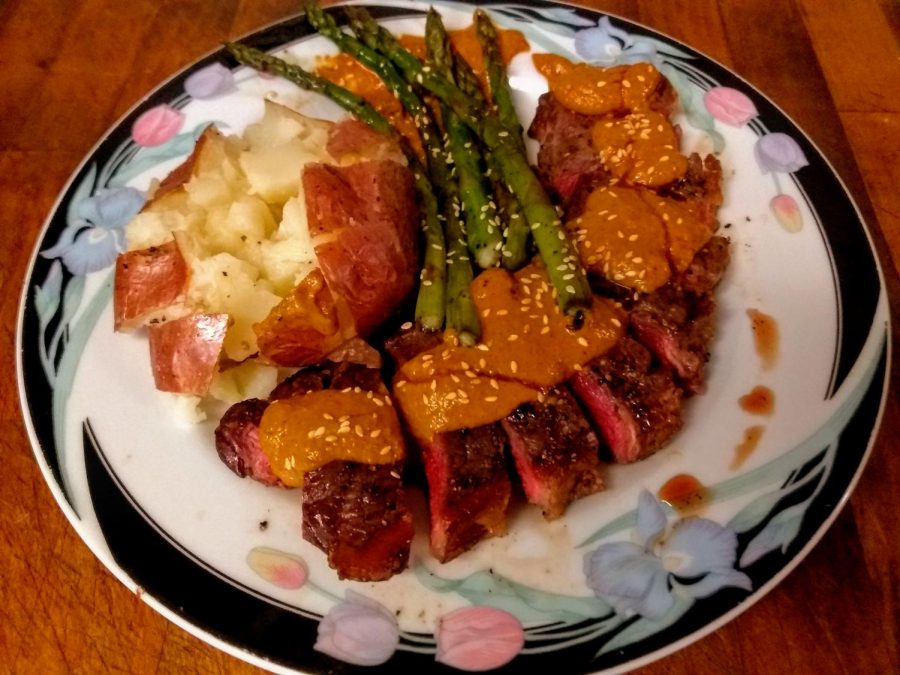My take on steak: excerpts of experience
Medium-rare grilled New York strip steak with mole, asparagus and baked potato, topped with toasted sesame seed.
The weather’s great, too hot to bake, so let’s talk steak. This is another guide to deliciousness, as opposed to a formal recipe. Like I mentioned in my “Simply Salmon” recipe, I’m well aware of the environmental impact that cattle, like fish, have on the planet. This means I eat steak rarely — no pun intended — but when those stars do align, I follow certain rules. From those rules, many flavors are possible, but for me, less is once again more.
Let’s cook.
I only add three ingredients to my steak before I cook it: olive oil, salt and pepper, but not necessarily in that order. First thing’s first — salt.
I like sea salt. Kosher, Himalayan and table salts will work, but the size of sea salt crystals is a happy median for my taste. It’s important to know what salt you’re working with to determine the appropriate amount. Kosher salt, for example, has larger grains than table salt. This means that a tablespoon of the former contains less than one of the latter. Adjust according to your taste, but for the purpose of explanation I’ll refer to sea salt moving forward.
If your steak is frozen, thaw it in the open, not in a microwave. Once thawed, salt both sides fairly liberally — I used about a teaspoon for both sides. Let it then come to room temperature for about a half an hour to an hour; the steak and its fat veins will be a considerably deeper red than before.
The salt helps pull out the internal moisture of the steak. A common misconception is that steaks need that internal moisture to be, well, moist. However, when a steak isn’t salted or dried before cooking, the resulting mouth-feel is, as best as I can describe it, watery. The real “moisture” that makes a steak mouthwatering comes from rendering the fat.
Let’s talk about fat.
There’s a certain temperature range that allows fat to render, or break down from its solid state. We’re not talking about the rubbery fat layer rimming a New York strip steak but the fat veins permeating the meat.
All preferences of steak doneness are correct, as taste is subjective. However, if a steak is rare, the fat will be more congealed. If it’s well-done, the fat cooks to a point where it hardens. For me, the sweet spot is more on the medium side of medium-rare, when the fat breaks down and still keeps its position in the meat.
Once the steak is about room temperature, drain or wipe off the excess moisture that’s been extracted and ignite your heating source. Drop about a teaspoon of oil on both sides, rubbing it to all corners and edges, and add more salt and fresh ground pepper to taste.
Regarding cooking time and temperature, this really depends on two factors: the type of cut you have and its thickness.
The type of cut is important because knowing the fiber density of your steak will determine how long it’ll take to break down without burning. Cuts like the shank (on the back leg) and chuck (on the shoulder) are used more by the cow, and therefore those areas build more muscle. These take longer to break down and are best in stews and roasts. The loins — short loin, sirloin and tenderloin, on the small of the back — aren’t exercised as much, thereby making the cut more tender and less dense with muscle. These cuts shouldn’t take long to reach your preferred doneness. The rib area falls in the middle — grilling is great and roasting works too, and when grilling, a longer time to cook through is needed compared to a loin.
I must agree, despite a mutual bias, with my editor: Ribeye definitely falls within my top three cuts, ahead of brisket and just behind top sirloin.
The thickness of the cut is important because thicker cuts need higher temperatures than thinner ones. The idea is to force heat, at first from one side and then the other after flipping, to meet in the middle of the steak. Logically, if you prefer a well-done steak, the time spent cooking on each side will be longer than if you like your steak rare. If you have a 2-inch thick steak, the heat will need to be higher so the inside will not cook through, otherwise leaving you with the hardened fat we discussed earlier. If you have a ½-inch steak the temperature should be lower because it’ll take less time for the heat to meet.
I’d prefer a steak that’s thicker but smaller in diameter than a thin, wide cut because of the wider range of control.
These two factors should help you determine both how hot and for how long you’ll want to cook your steak. Speaking of, what’s your heat source?
I don’t think a grill can be beat. Whether you use a gas or charcoal grill, heat should be constant for steak throughout its cooking cycle, so don’t worry about a hot side versus a cold one. I also appreciate the grill’s ability to apply gill marks, which is achieved by cutting the time one side of a steak is set to cook in half and rotating the steak 45 degrees during the rest of that side’s cooking cycle, before flipping and repeating the process.
Pan-frying a steak has its own benefits, too. Sometimes, I’ll put my cast iron on the grill if it’s too hot to cook inside when I still want to baste while the steak’s cooking. A quick tip is to chop up some fresh rosemary beforehand. Once you flip the steak in the pan, add a tablespoon of butter and the rosemary, then spoon that mixture on the steak occasionally. You’re welcome.
I wouldn’t recommend baking, pressure-cooking or deep-frying a steak. A steak’s flavor should be appreciated, and methods like these either cook that flavor out or mask it.
Like every meat, baked good, rice or egg-based dish, etc., let your steak rest. Don’t touch it for at least five minutes after removing it from the heat onto a preferably warm plate. I prefer closer to 10 minutes, just to make sure the fibers and fats have time to pull themselves together. If your steak leaks a deluge of juice when it’s cut, it most likely hasn’t set fully. Some juice extract is fine, but too much — over a tablespoon, let’s say — results in a dry, tough piece of meat.
Really, this is it. Experiment, find what works best for you and become more familiar with herbs, sides and homemade sauces like mole as you go. If you get these basics down, you’ll be a cut above at your next cookout.
Ian Hilton can be reached at [email protected]


















